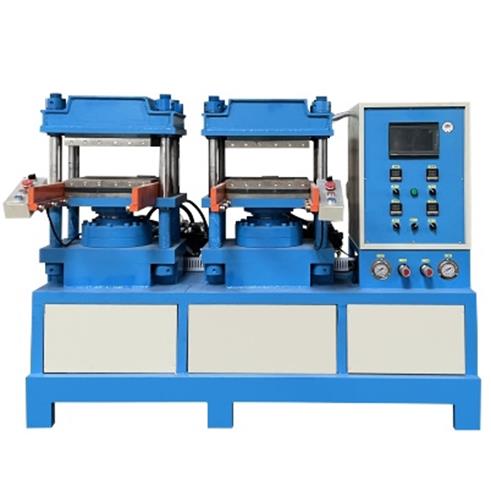
Rubber Plate Vulcanizing Machine (Rubber Plate Vulcanizing Machine) is a special equipment used in the rubber vulcanization process, which is widely used in the rubber manufacturing industry. The equipment makes the rubber material undergo vulcanization reaction through heating, pressurization and time control, thereby improving the elasticity, strength and wear resistance of the rubber, and finally producing rubber products with excellent performance. Vulcanization is a key link in rubber processing and can significantly improve the physical and chemical properties of rubber.

Model | YX-DJ50T |
Hot plate specification | 350*350mm |
Hot plate spacing | 150mm |
Cylinder diameter | cp150mm |
Machine structure | Four column/single head/double head model |
System pressure | 18MPa |
Heating system | Imported electric heating tube |
Power supply specification | 380V/50HZ |
Main specifications and dimensions:
Working platform size: Generally customized according to customer needs, common working platform sizes range from 500mm x 500mm to 2500mm x 2500mm.
Machine size: The overall size of the machine will vary depending on the pressure and the size of the workbench, usually about 1500mm x 1500mm x 2000mm in length, width and height.
Maximum working pressure: Usually ranges from 10~50MPa, which can be adjusted according to different vulcanization requirements.
Heating system: electric heating, steam heating, oil heating, etc., different types can be selected according to needs.
Essential details | |||
Place of Origin | China | Applicable Industries | Hotels, Machinery Repair Shops, Home Use |
Type | Showroom Location | None | |
Condition | New | Model | YX-DJ50T |
Video outgoing-inspection | Provided | Hot plate specification | 350*350mm |
Machinery Test Report | Provided | Hot plate spacing | 150mm |
Warranty of core components | 1 Year | Cylinder diameter | cp150mm |
Core Components | PLC | Motor power | 3.75KW |
Voltage | 300V/50HZ | Temperature range | Normal temperature -350°C |
Dimension(L*W*H) | 1.0*1.3*1.5(m) | Working level | Upper and lower layer |
Warranty | 1 Year | Machine structure | Four column/single head/double head model |
Key Selling Points | Automatic | System pressure | 18MPa |
Power (kW) | 3.75 kW | Reducer casing | Power supply specification |
Features:
Versatility: The Rubber Plate Vulcanizing Machine has multiple working modes such as heat conduction vulcanization and hydraulic vulcanization. It can choose the appropriate vulcanization method according to different rubber materials and product requirements.
High-precision temperature control system: The equipment is equipped with a precise temperature control system, which can ensure that the rubber plate is uniformly vulcanized at the optimal temperature and improve product quality.
High efficiency: The use of advanced heat transfer vulcanization technology and hydraulic system enables the equipment to work efficiently while ensuring a continuous and stable vulcanization effect.
Customized production: Customized rubber plate production solutions can be provided according to customer needs to meet the manufacturing of rubber plates of different specifications and thicknesses.
Advantages:
Improve rubber performance: Through vulcanization reaction, the high temperature resistance, corrosion resistance, wear resistance and other properties of rubber plates are significantly enhanced, and are widely used in industrial production.
High production efficiency: The Rubber Plate Vulcanizing Machine completes the rubber vulcanization process in a short time, ensures the rapidity of production, and adapts to large-scale production needs.
Energy saving and environmental protection: The equipment adopts advanced energy-saving technology, which can efficiently utilize energy, reduce energy waste, and conform to the modern green production concept.
Strong adaptability: Whether it is ordinary rubber products or customized rubber plates, this vulcanizing machine can provide stable vulcanization effects to meet the needs of different fields.
Scope of use:
Rubber production process: Rubber Plate Vulcanizing Machine is widely used in the production process of rubber products such as rubber plates, rubber sheets, rubber belts, etc., especially in industrial rubber processing, such as sealing gaskets, automobile tires, industrial gaskets, etc.
Automotive industry: In the production of automotive accessories, vulcanized rubber plates are used to manufacture automotive parts such as rubber pads, sealing strips, suspension systems, etc.
Home appliance industry: Used to manufacture rubber products such as home appliance sealing strips and wire insulation.
Other industrial uses: In industries such as construction, medical equipment, aerospace, and petrochemicals, Rubber Plate Vulcanizing Machine can be used to produce a variety of high-strength, high-temperature-resistant, and corrosion-resistant industrial rubber products.
FAQ
What should I do if the rubber is uneven during vulcanization?
Uneven vulcanization may be caused by uneven heating of the equipment or a malfunction in the temperature control system. It is recommended to check the accuracy of the temperature control system and the heat distribution of the equipment to ensure that the heat is evenly distributed in each part.
How to solve the problem of unstable hydraulic system?
The instability of hydraulic system may be caused by insufficient hydraulic oil or problems with the hydraulic pump. Regularly check the hydraulic oil level and the sealing of the system, and perform necessary maintenance to ensure the normal operation of the hydraulic system.
How to extend the service life of Rubber Plate Vulcanizing Machine?
Regularly cleaning and lubricating the equipment, keeping the hydraulic system, heating system and other key components in good condition, and replacing worn parts in time can effectively extend the service life of the machine.
How to choose the appropriate vulcanization temperature and time?
The selection of appropriate temperature and time usually depends on the characteristics of the rubber material and the requirements of the product. You can refer to the technical specifications of the rubber raw material supplier or optimize the vulcanization parameters through experiments.